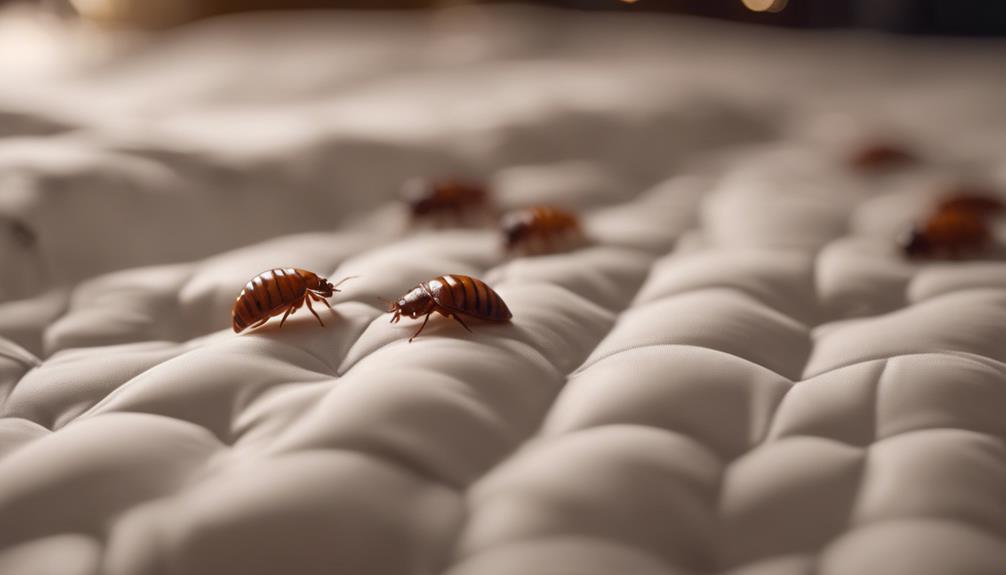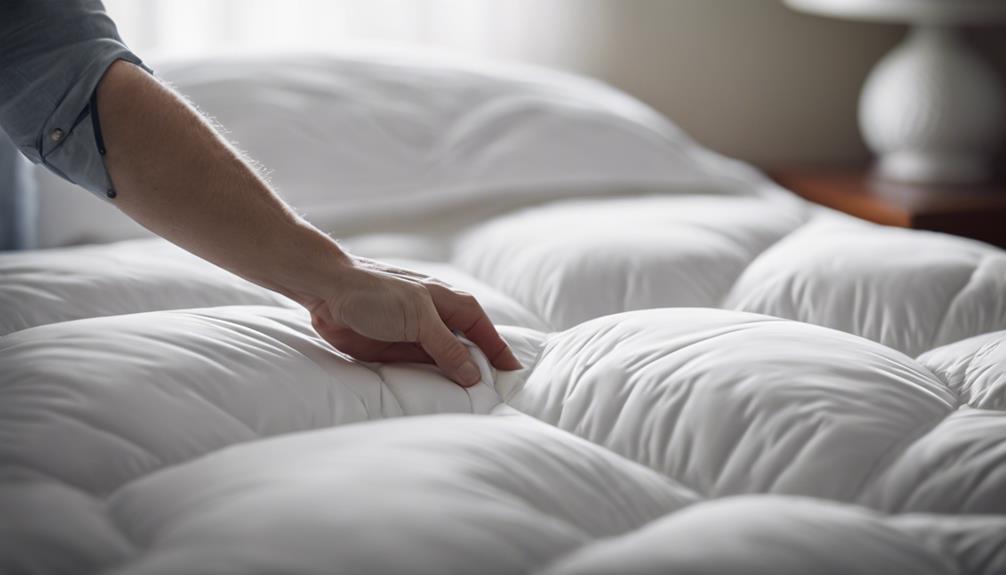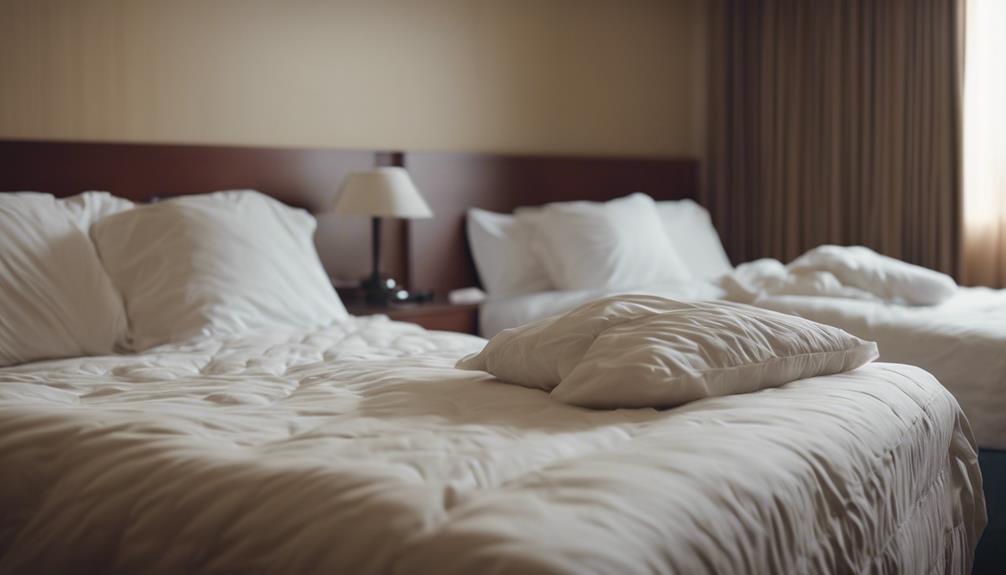Yes, bedding can attract bed bugs. Be on the lookout for small reddish-brown stains, tiny eggs, shed skins, and a musty odor as indicators of an infestation. Pay close attention to seams, folds, and crevices where bugs tend to hide. If you spot any bugs, stains, or evidence of bugs in hiding spots, take immediate action. Regularly clean and inspect your bedding, use protective covers, and consider high heat treatment to prevent infestations. Before washing, thoroughly inspect your bedding, ensure high heat, and make sure it is completely dry before storing in sealed bags. Stay proactive and remember that recognizing signs and implementing preventive measures is crucial to keeping your bedding bug-free.
Key Takeaways
- Comforters can have bed bugs hiding in seams and folds.
- Look for tiny reddish-brown stains, eggs, and a musty odor.
- Regularly inspect, wash on high heat, and seal in plastic to prevent infestation.
- Use encasements for protection and consider professional treatment for elimination.
- Bed bug behavior includes hiding in cracks, seams, and near labels.
Bed Bug Infestation in Comforters

When dealing with bed bug infestation in comforters, we must act promptly to prevent further spread and guarantee effective eradication. Signs of bed bug presence in comforters include small reddish-brown stains from their fecal matter, tiny eggs or eggshells, shed skins, and sometimes a musty odor. Detecting these signs early on is vital in combating the infestation promptly. It's important to thoroughly inspect all seams, folds, and crevices of the comforter to make sure no bed bugs or eggs remain hidden.
Once signs of bed bugs are identified, it's recommended to wash the comforter in hot water and dry it on high heat to kill any bed bugs present. Additionally, vacuuming the comforter and surrounding areas can help eliminate any bed bugs that may be lurking nearby. Regularly cleaning and inspecting comforters can help prevent the establishment of bed bug infestations and promote a healthier sleeping environment for all.
Signs of Bed Bugs in Comforters

When inspecting comforters for signs of bed bug activity, keep an eye out for visible bugs on the fabric and reddish-brown stains that may indicate their presence.
These pests are known to hide in the seams and folds of comforters, making thorough examination essential.
Discovering these signs can help in taking prompt action to address a potential bed bug infestation in your bedding.
Visible Bugs on Comforter
Bed bug infestations in comforters can be detected through visible signs such as small brown or red stains from fecal matter and blood, as well as the presence of tiny ivory-colored bed bug eggs. When inspecting your comforter for bed bugs, keep an eye out for these key indicators:
- Small Stains: These stains may appear as tiny dots or smears on the fabric.
- Blood Spots: Reddish-brown spots on the comforter could indicate crushed bed bugs or their feces.
- Egg Shells: Look for small, oval-shaped ivory-colored eggs that are about 1mm in size.
- Musty Odor: A musty or sweet scent on the comforter may suggest a bed bug infestation.
If you notice any of these signs, it's important to take immediate action.
Reddish-Brown Stains Present
Reddish-brown stains found on comforters are a clear indicator of potential bed bug infestation. These stains, often fecal spots left behind by bed bugs, can also include blood stains from their feeding. Identifying these marks is important in detecting a bed bug presence early on. Below is a helpful table showcasing how bed bugs' fecal and blood stains look on comforters:
| Bed Bugs Look | Description |
|---|---|
| Fecal Spots | Small, reddish-brown stains |
| Blood Stains | Darker, reddish-brown streaks |
If you notice these signs on your comforter, it's vital to take prompt action to address the bed bugs and prevent further infestation.
How Bed Bugs Hide in Comforters

Nestled within the plush layers of comforters, bed bugs stealthily await their warm-blooded hosts for feeding. Here are four ways these sneaky pests hide in comforters:
- Cracks and Seams: Bed bugs can snugly tuck themselves into the tiny crevices of comforter seams, making it important to spot them with a cursory glance.
- Between Layers: The thick, layered structure of comforters provides ample hiding spots for bed bugs to burrow deep within, shielded from detection.
- Near the Edges: Bed bugs often position themselves close to the edges of comforters, where they can easily crawl out to feed on unsuspecting sleepers.
- Under Labels: Labels stitched onto comforters can also serve as a cozy refuge for bed bugs, offering a discreet hiding place that's commonly overlooked during inspections.
Understanding these hiding spots is essential for effectively combating bed bug infestations in comforters. Regular inspections and proper treatment methods can help in keeping these pests at bay.
Preventing Bed Bugs in Comforters

Regular cleaning and inspection of comforters is crucial in preventing bed bugs from infesting these cozy bedding essentials. Bed bugs are attracted to the warmth and hiding spots in comforters, making them susceptible to bug infestations if not properly maintained.
One proactive measure against bed bugs is to use protective covers on comforters, acting as a barrier to prevent infestations. Additionally, high heat treatment in the dryer can effectively kill bed bugs and their eggs that may have found their way into the comforter.
By incorporating these preventive measures into your regular bedding care routine, you can greatly reduce the risk of bed bug infestations in your comforters. Remember, being diligent with cleaning, inspecting, and using protective covers can go a long way in keeping your comforters bug-free and your sleep environment comfortable and cozy.
Stay proactive and attentive to make sure your bedding remains a sanctuary free from unwelcome bug guests.
Cleaning Comforters for Bed Bugs

To effectively eliminate bed bugs from comforters, thorough cleaning on high heat in the dryer is essential. When dealing with bed bugs in your bedding, it's important to take a proactive approach. Here are some steps to keep in mind when cleaning comforters for bed bugs:
- Inspect Thoroughly: Before washing, take a close look at your comforter for any signs of bed bugs such as dark spots or shed skins.
- Wash on High Heat: Use the hottest setting on your washer and dryer to make sure that bed bugs at all life stages are exterminated effectively.
- Dry Completely: Ensure that the comforter is completely dry as any residual moisture can lead to mold growth.
- Seal in Plastic Bags: After cleaning, enclose the comforter in durable plastic bags to prevent re-infestation and keep it protected until further use.
Using Encasements for Bed Bug Protection

When safeguarding comforters against bed bugs, utilizing encasements serves as an essential barrier to prevent infestation. Encasements for comforters act as a protective shield, preventing bed bugs from entering or escaping. These specialized covers create a barrier that traps any existing bed bugs inside, while also deterring new ones from infesting the comforter. High-quality encasements are designed to be durable, breathable, and specifically made to be bed bug-proof, ensuring effective protection for your bedding.
Using encasements is a practical and cost-effective measure to safeguard your comforter and prevent bed bug infestations. They're easy to install and maintain, adding convenience to your bed bug prevention routine. By investing in encasements for your comforters, you're taking a proactive step towards keeping your bedding safe and free from these unwanted pests. Remember, prevention is key when it comes to dealing with bed bugs, and encasements play an important role in keeping your comforter bed bug-free.
Inspecting Comforters for Bed Bugs

When shifting our focus to inspecting comforters for bed bugs, it's crucial to be vigilant for any signs of infestation in the fabric and seams. Here are some key steps to effectively inspect your comforter:
- Check for Stains: Examine your comforter for brown or red stains, as these could be indicative of bed bug activity.
- Look for Eggs: Bed bugs are known to lay eggs in fabrics like comforters, so carefully inspect the seams and folds for any tiny eggs.
- Consider Heat Treatment: High heat treatment in the dryer can be a potent way to kill bed bugs, their eggs, and nymphs residing in your comforter.
- Use Plastic Bags: After cleaning your comforter, sealing it in a plastic bag can help prevent any potential reinfestation by bed bugs.
Frequently Asked Questions
How Can I Tell if My Bedding Has Bed Bugs?
To tell if bedding has bed bugs, check for brown or red stains, live bugs, or shed skins. Inspect seams, folds, and crevices with a flashlight and magnifying glass.
Wash the bedding in hot water and dry on high heat if you suspect bed bugs. This kills bugs, eggs, and nymphs. Regularly inspect for signs to catch infestations early.
Trust your instincts and take action promptly for peace of mind.
Can You Wash Bed Bugs Out of Blankets?
We wash bed bugs out of blankets by using high heat in the dryer. Hot water above 120°F kills bed bugs, including eggs and nymphs. Regular laundering on high heat can prevent and eliminate infestations, as bed bugs are heat-sensitive.
Proper washing is essential for bug control, keeping bedding bug-free. Remember, high temperatures are key for banishing bed bugs from your blankets.
Should I Throw Away My Pillows if I Have Bed Bugs?
If you suspect bed bugs in your pillows, it's advisable to inspect them thoroughly.
Washing the pillows on a high heat setting can help eliminate bed bugs.
If the infestation is severe or the pillows are heavily infested, it may be best to dispose of them to prevent further spread.
Always seal infested items in plastic bags before discarding to contain the pests.
Regularly inspect and treat surrounding areas to prevent reinfestation.
How to Clean a Comforter of Bed Bugs?
We can clean a comforter of bed bugs by putting it in the dryer on high heat to eliminate eggs, nymphs, and adults.
Sealing clean linens in durable plastic bags helps prevent reinfestation.
Avoiding insecticide sprays is important as they may not work well and can leave stains and odors.
If bed bugs persist, it's best to contact a pest control professional for effective treatment.
Can Bed Bugs Transfer from Down Comforters to Other Bedding?
Yes, down comforters and dust mites can transfer bed bugs to other bedding. Bed bugs can hide in the folds and crevices of down comforters and easily transfer to other bedding when in contact. Regular washing and drying of down comforters can help prevent the spread of bed bugs.
Conclusion
To sum up, comforters can indeed harbor bed bugs, making it important to regularly inspect and clean them to prevent infestations.
One example of this is a family who unknowingly brought bed bugs into their home through a used comforter they purchased at a thrift store, leading to a costly and stressful extermination process.
By staying vigilant and taking proactive measures, you can protect your home and family from these unwanted pests.










